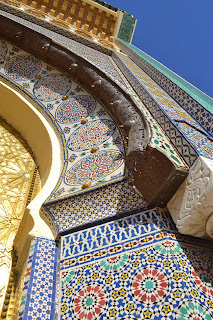Last Sunday, I left the Rabat area for the first time and set off to Fez and the Middle Atlas with the rest of my group and our wonderful leader Sarah. The city of Fez is home to the biggest medina in the world and we spent a day and a half exploring the city before winding our way through the mountains. We've all heard it said: photos are worth a thousand words. Here's some of my favorites from the trip:
The Royal Palace in Fez on the first day of our trip.
Artisans gave the tile work on the Royal Palace to the former King to show their appreciation for his support of the arts.
The Mellah or Jewish Quarter of Fez. The balconies found there are one of the differences between the Mellah and the Medina.
We had the opportunity to visit a synagogue turned museum, where we learned more about the Fezi Jew population. At its peak, 22,000 Jews lived in Fez, but now only about 150 remain.
Overlooking the beautiful Medina of Fez. There are two sides--the Qaraweeyan and Andalucian. The first university in the world (founded by a woman!) is in Fez.
One of the many shops in the Medina. We toured the Medina at night and returned the next day on our own. I loved seeing it at its most busy and quietest times. The multilingualism of the shopkeepers impressed me. Because Fez is a huge tourist destination, many of the shopkeepers spoke Darija, French, and English.
One of the many doors or "baabs" that serve as entrances to the Medina.
Tanneries Chwarma! I visited the tanneries at their most active point--the morning--and bought a leather bag there. The tanneries have a distinct smell, as the leather workers soften the animal skin by soaking it in pigeon poop.
The winding streets of Fez. Getting lost in the Medina is unavoidable and actually pretty fun! Currently, 150,000 people live within the walls of the Fez Medina. As I walked the streets, I pondered all the changes that the walls have seen since their creation in 789 A.D. It's fascinating to consider that people have tread the same paths for thousands of years and will continue to do so for thousands more.
Because there are no cars in the Medina, donkeys and motorcycles are used to transport goods through the narrow streets. The tall buildings cast shadows in the alley, which keeps the Medina cool in the hot summer months. As our guide said, "It is cool and dark. In the alley there isn't a divison of class."
Place de Seffarine is a square where copper workers shape metal into kitchenware, jewelry, and tools. Throughout the day, their hammers can be heard connecting with metal, creating what is known as the "song of Seffarine."
I loved the shopping Fez and went a little bit crazy. One of my favorite purchases is lip redden-er from the henna souk inside the Medina. It's a small bowl covered in reddish paint and stays on for a very long time!
After spending a whirlwind day and half in Fez, we headed to the countryside. Our first destination: Moulay Yacoub, a small down nestled on a hillside and known primarily for its sulfur springs. Before bathing in the springs, we hiked to the top of the mountain opposite Moulay Yacoub.
Overlooking Moulay Yacoub. After two months in the bustling city, I welcomed the fresh air and quiet! From the top of the mountain, we could hear the men and women inside the hammam singing call and response. Going to Moulay Yacoub is somewhat of a pilgrimage, as the water is thought to cure skin diseases.
The entire group post our Moulay Yacoub adventures! We had two options for bathing--private and public. In the private hammam, each person has their own bathtub in a single room for half an hour. I opted for the public hammam. Inside, I found a single chamber with a large pool of HOT sulfur water in the middle. Women crowded the room, all fighting to find their spot to bathe in the mineral rich water. Thanks to the assistance of some kind women, I found a spot on the side of the pool and participated in the rituals of scrubbing, combing, and jumping into the scalding water!
After our visit to Moulay Yacoub, we continued to Azrou, a small town in the Atlas mountains. We had the fortune of visiting the weekly souk there as well!
I really enjoyed Azrou. It kind of looked like how I imagine Germany!
Blue Djellaba Club! Djellabas are traditionally worn by men and women in Morocco over other clothing. I'm in love with mine and can't wait to get another!
Oddly, monkeys are native to the Cedar forests in the Middle Atlas! Our group had a great time looking for monkeys, chasing monkeys, and taking pictures with monkeys. Monkey see, monkey do.
From Azrou, we moved onto visit two small villages--Ain Leiu and Oum Er-Rbia. This picture is the view from the restaurant where we ate tajine in Oum Er-Rbia. Oum Er-Rbia means "Mother Source" in Darija and is the source of a river which shares its name.
We hiked to this beautiful waterfall in Oum Er-Rbia before heading back to Rabat!
I really enjoyed the chance to see more of Morocco. The more I learn of my host country, the more I realize how much more there is to understand. A few days ago, we were asked by a lecturer to sum up Morocco in one word. I chose the word "contrast." Morocco is a country where different ideologies and lifestyles interact, collide, and mix. As the two month mark of my exchange passes, I'm grateful for all that I have experienced and excited for the days ahead.





























